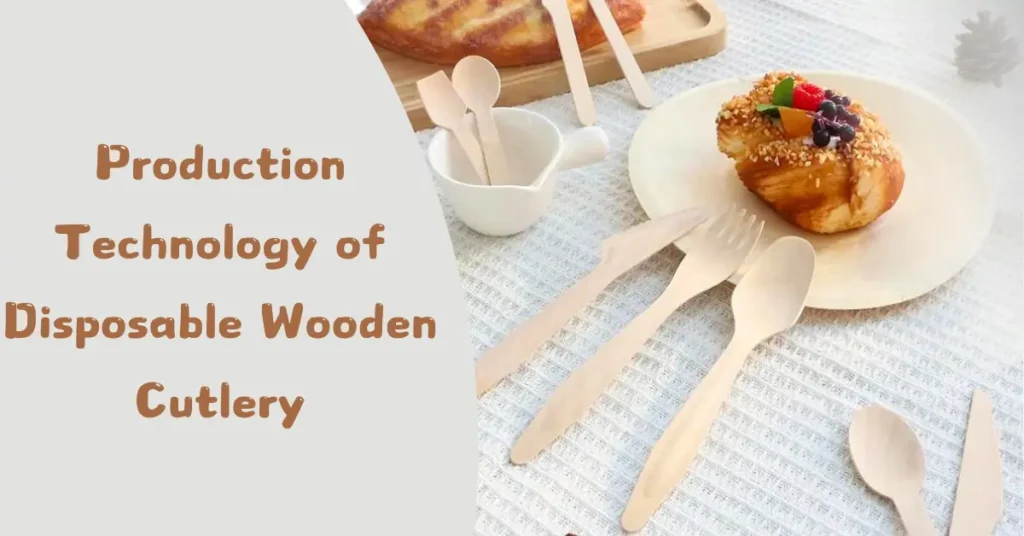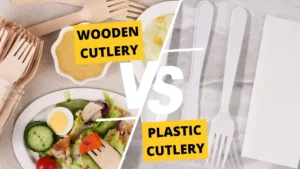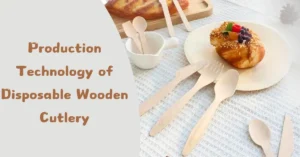Disposable wooden cutlery has gained immense popularity in recent years as a sustainable alternative to traditional plastic utensils.Made from renewable resources, such as birch or bamboo, it offers an eco-friendly option for various events and occasions.But have you ever wondered about the production technology of disposable wooden cutlery?
The production technology of disposable wooden cutlery is carried out every step of the way, from the selection of raw materials to the final packaging, to ensure the highest quality and durability of these cutlery items.
Say goodbye to disposable plastics and embrace disposable wooden tableware options. It not only reduces the negative impact on our planet, but also adds a touch of elegance to any dining experience. So join the sustainability movement and discover the production technology behind these eco-friendly tableware options.
Advantages of Using Disposable Wooden Cutlery
In today’s eco-conscious world, disposable wooden cutlery stands out as a beacon of sustainability and functionality. The advantages of opting for wooden utensils over plastic or other materials are manifold, highlighting the blend of environmental care with practical utility. Here, we delve into the multifaceted benefits of wooden cutlery, emphasizing why they are becoming the go-to choice for environmentally aware consumers and businesses alike.

Sustainability and Environmental Impact
Wooden cutlery is crafted from renewable resources, typically deriving from fast-growing species that are harvested responsibly. This sustainable sourcing minimizes environmental impact, contributing to a lower carbon footprint compared to plastic alternatives. Moreover, wooden cutlery is biodegradable and compostable, offering a guilt-free convenience that aligns with the global push towards reducing plastic waste in our oceans and landfills.
Safety and Health Benefits
Unlike plastic cutlery, which can leach harmful chemicals when in contact with hot substances, wooden cutlery offers a safer, non-toxic alternative for consumers. Wood’s natural properties also include antibacterial and antimicrobial effects.

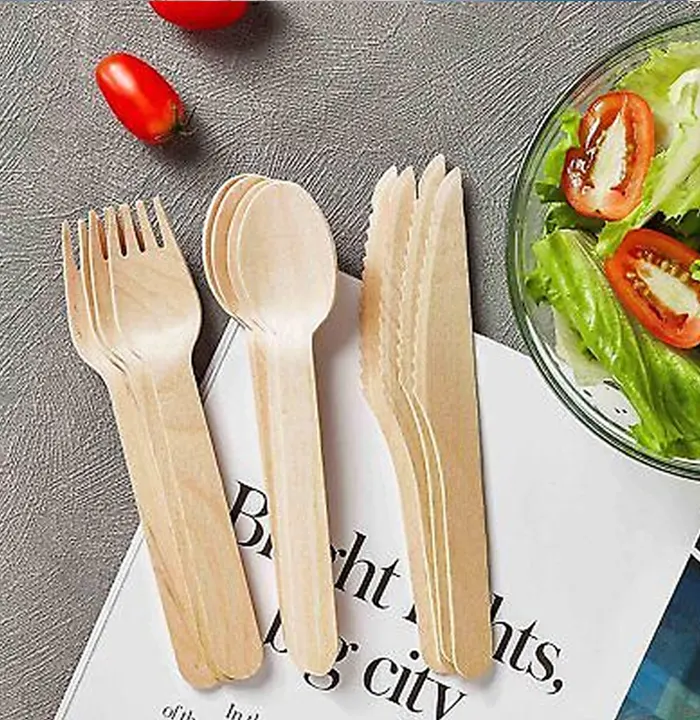
Aesthetic and Tactile Appeal
There’s an undeniable charm to the rustic, natural look of wooden cutlery that enhances the dining experience. The warmth and unique grain patterns of wood add a touch of elegance to any setting, from casual picnics to formal events. Furthermore, wooden cutlery provides a pleasant tactile sensation, being gentle on the mouth and easy to handle, contributing to an overall satisfying user experience.
Customization and Branding Opportunities
The versatility of wood allows for a high degree of customization. Businesses can easily have their logos, messages, or designs engraved on wooden cutlery, making it a powerful branding tool. This customization not only increases brand visibility but also adds a personal touch that resonates with consumers, fostering a stronger connection between the brand and its audience.
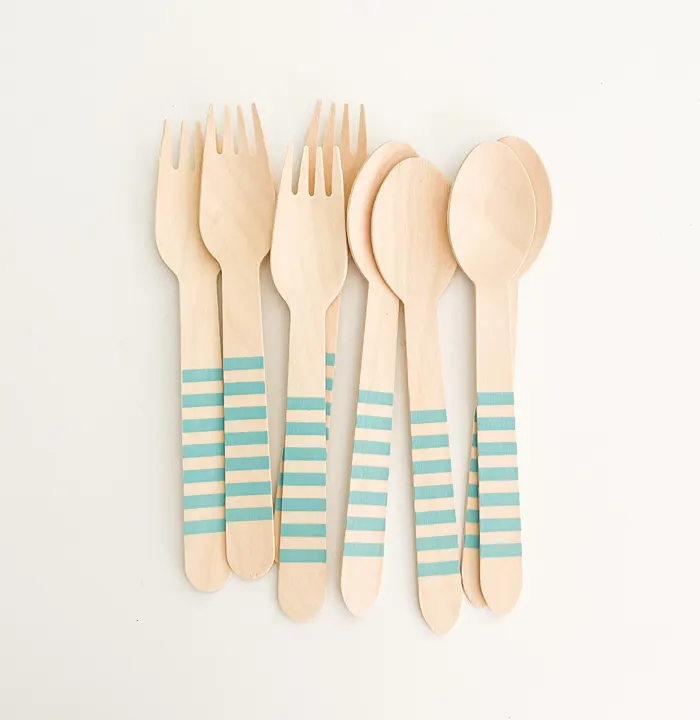
What Materials Are Used to Make Disposable Wooden Cutlery?
Selecting the right material is crucial in the production of disposable wooden cutlery. The choice of wood not only influences the product’s environmental impact but also its strength, durability, and overall user experience. This section explores the various types of wood used in cutlery production, highlighting their characteristics and suitability for different applications.
Commonly Used Woods
- Birchwood: Birchwood is a popular choice for disposable wooden cutlery due to its availability, affordability, and strength. It is lightweight yet sturdy, making it suitable for various culinary uses.
- Bamboo: Bamboo is another commonly used material for disposable wooden cutlery. It is fast-growing, renewable, and biodegradable, making it an eco-friendly option. Bamboo cutlery is lightweight, durable, and suitable for both hot and cold foods.
- Maplewood: Maplewood is occasionally used for disposable wooden cutlery. It offers a smooth texture and is relatively durable. However, it may not be as widely available or as cost-effective as birchwood or bamboo.
- Beechwood: Beechwood is sometimes utilized for disposable wooden cutlery. It has a fine grain and is reasonably durable. While less common than birchwood or bamboo, it can still be found in some disposable utensil products.
- Pine: Pine wood is less common in disposable wooden cutlery but may still be used in some products. It is lightweight and readily available, but it may not be as durable or as smooth as other types of wood.
Considerations for Material Selection
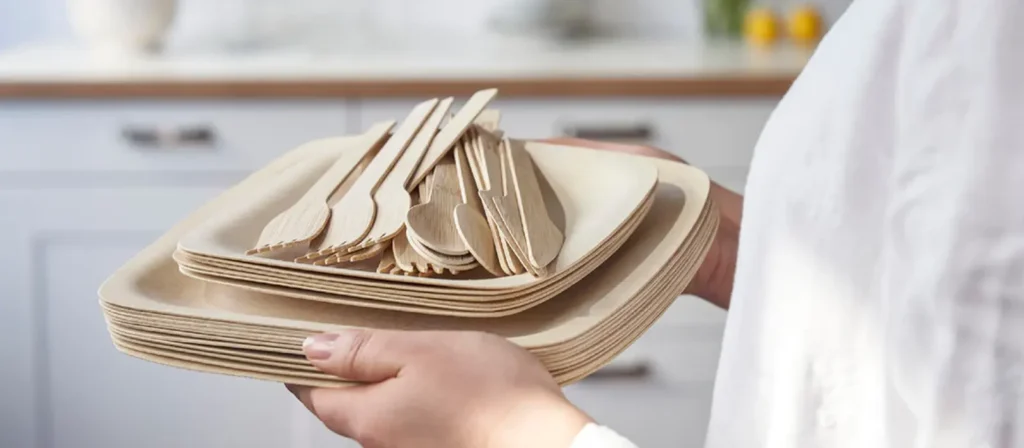
When choosing materials for wooden cutlery, manufacturers must consider factors such as the wood’s impact on the environment, its availability, and cost-effectiveness. The wood should be sourced from sustainably managed forests, ensuring that production promotes environmental conservation and sustainability. Additionally, the material’s aesthetic appeal and ability to be customized play a significant role in its selection, as these attributes can greatly enhance the product’s marketability.
Production Technology of Disposable Wooden Cutlery
Production technology of disposable wooden cutlery includes various stages, each carefully designed to ensure that the final product meets high standards of quality and sustainability. From the selection of suitable raw materials to the final drying and humidity control.
1.Choose Raw Materials
The choice of wood is the first and perhaps most critical decision in the production process. Sustainable sources like birch, bamboo, or poplar are preferred for their fast growth rates and minimal environmental impact. The selection criteria not only include sustainability but also the wood’s suitability for crafting cutlery, such as grain, strength, and ease of processing.
2.Preparation
Once the wood is selected, it undergoes preparation, which may involve cleaning, sorting, and sometimes treating the wood to ensure it’s safe for use.
3.Peel
Peeling is a pivotal process where the wood is stripped of its bark and outer layers, revealing the clean, smooth surface required for cutlery production. This step must be done with care to preserve the integrity of the wood, preventing unnecessary waste and ensuring the material’s consistent quality.
4.Cut the Shape
Using precision machinery, the wood is then cut into the shapes of spoons, forks, and knives. This process demands accuracy to ensure each piece of cutlery matches specific dimensions and standards.
5.Drying and Humidity Control
Drying the cutlery and carefully controlling the humidity to ensure that the wood does not warp or crack. Proper drying and humidity control not only improves the durability of the product, but also the safety of its use.
6.Polishing and Grinding
Once the basic shape of the cutlery has been molded, the next critical step is polishing and grinding. High-grade polishing equipment and meticulous hand finishing processes are used to achieve a smooth, flawless finish on every piece of cutlery.
7.Quality Control and Safety Standards
Quality control is paramount in the production of disposable wooden cutlery. Each piece undergoes rigorous testing to ensure it meets international safety and quality standards. This includes checks for splinters, strength, and overall integrity.
8.Coating and Finishing
A crucial step in the production process is the application of a safe, food-grade coating. This coating protects the cutlery from moisture and enhances its durability.
9.Package
Once the manufacturing process is complete, the disposable wooden tableware is carefully packaged to ensure safe transportation and storage. Recyclable or biodegradable materials are often used to ensure that the packaging is in line with the sustainable ethos of the product itself.
10.Distribution
The final step in bringing disposable wooden tableware to market is distribution. Efficient logistics ensure that the product reaches retailers, food services and other organizations in good condition. A well-organized distribution network also minimizes the environmental footprint and is in line with the core sustainable values of disposable wooden tableware production.
Production cost analysis of disposable wooden cutlery
Understanding the production costs involved in making disposable wooden cutlery is essential for both manufacturers and consumers. These costs influence the pricing, competitiveness, and sustainability of the products in the market.
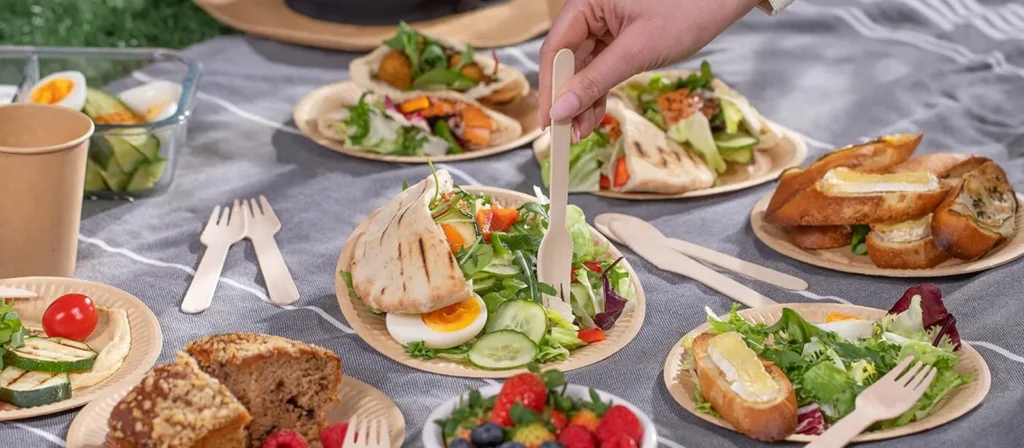
Raw Material Costs
The type of wood chosen for cutlery production significantly affects the overall cost. While birch and bamboo are relatively affordable and sustainable, the cost can vary based on availability, quality, and sustainability certifications.
Manufacturing and Labor Costs
Advanced production technologies, while efficient and capable of producing high-quality cutlery, require significant initial investments in machinery and ongoing maintenance. Additionally, skilled labor is necessary to operate these machines and manage the production process, contributing to the overall cost.
Market Demand for Disposable Wooden Cutlery
The global demand for disposable wooden cutlery has seen a significant uptick in recent years, driven by increasing awareness of plastic pollution and a shift towards sustainable living practices.

Environmental Awareness and Regulations
With the rise in environmental awareness, the demand for eco-friendly alternatives to plastic cutlery has surged. Regulations banning single-use plastics in many regions are driving the market for disposable wooden cutlery.
Catering and Food Service Industry
The catering and food service industry, including restaurants, cafes, and event organizers, are the major consumers of disposable wooden cutlery.
Consumer Preferences and Trends
The trend towards sustainability, coupled with wooden cutlery, is becoming the preferred choice for many consumers. The ability to customize and brand flatware has also made it popular for corporate events, weddings and other special occasions.
Conclusion
Production technology of disposable wooden cutlery from the sustainable harvesting of materials to the complex process of molding, finishing and branding, demonstrates the industry’s commitment to quality, sustainability and innovation at every step of the way. As environmental awareness continues to grow, disposable wooden tableware is a prime example of industry and eco-consciousness going hand in hand, offering a viable and attractive alternative to plastic.

